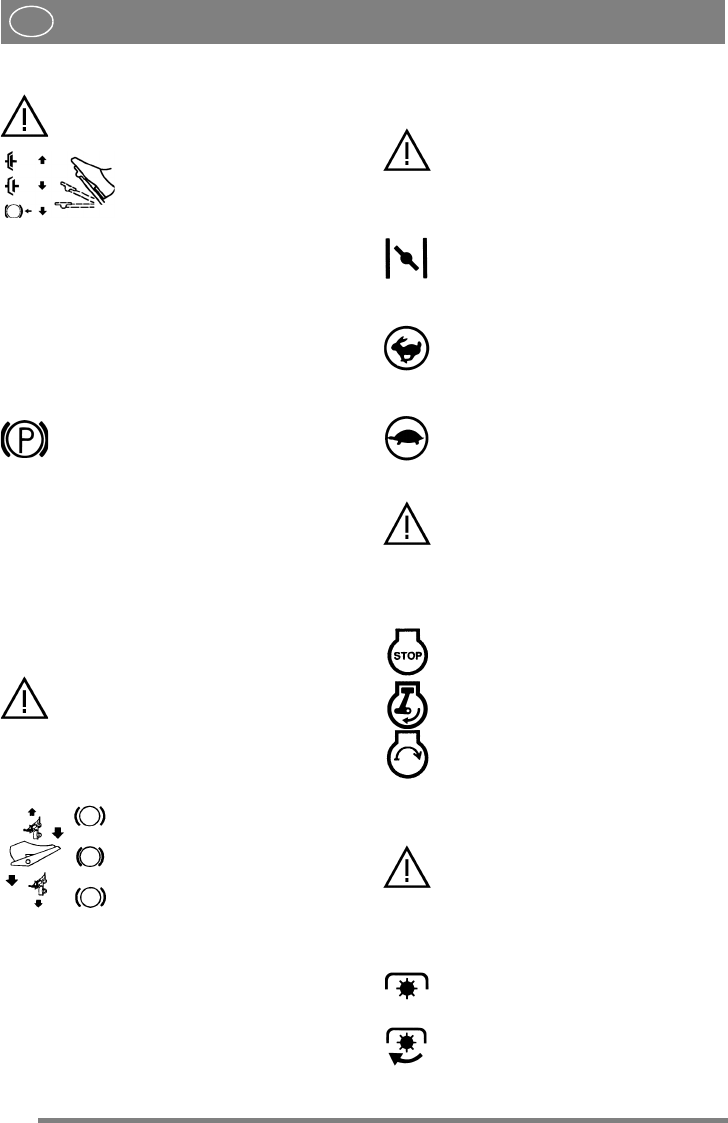
12
ENGLISH
EN
5.4.2 Clutch-parking brake (12:B)
Never press the pedal while driving.
There is a risk of overheating in the
power transmission.
The pedal has the following
three positions:
• Released. The clutch is not activated. The park-
ing brake is not activated.
• Depressed halfway. Forward drive disengaged.
The parking brake is not activated.
• Fully depressed. Forward drive disengaged.
The parking brake is fully activated but not
locked. This position is also used as emergency
brake.
5.4.3 Inhibitor, parking brake (12:C)
The inhibitor locks the “clutch-brake”
pedal in the depressed position. This func-
tion is used to lock the machine on slopes,
during transport, etc., when the engine is
not running.
Locking:
1. Depress the pedal (14:B) fully.
2. Move the inhibitor (14:C) to the right.
3. Release the pedal (14:B).
4. Release the inhibitor (14:C).
Unlocking:
Press and release the pedal (14:B).
5.4.4 Driving-service brake (12:F)
If the machine does not brake as expect-
ed when the pedal is released, the left
pedal (12:B) should be used as an emer-
gency brake.
The pedal determines the gearing ratio between the
engine and the drive wheels (= the speed). When
the pedal is released, the service brake is activated.
1. Press the pedal forward –
the machine moves forward.
2. No load on the pedal – the ma-
chine is stationary.
3. Press the pedal backward –
the machine reverses.
4. Reduce the pressure on the
pedal – the machine brakes.
5.4.5 Throttle and choke control (12:D)
A control for setting the engine speed and to choke
the engine when starting from cold.
If the engine runs unevenly there is a
risk that the control is too far forward
so that the choke is activated. This dam-
ages the engine, increases fuel con-
sumption and is harmful to the
environment.
1. Choke – for starting a cold engine. The
choke position is located at the front of the
groove.
Do not operate in this position when the
engine is warm.
2. Full throttle – when the machine is in
operation, full throttle should always be
used.
The full throttle position is approximately
2 cm behind the choke position.
3. Idling.
5.4.6 Ignition lock (12:E)
Do not leave the machine with the key
in position 2 or 3. There is a fire risk,
fuel can run into the engine through the
carburettor, and there is a risk of the
battery being discharged and damaged.
Ignition lock used for starting/stopping the engine.
Four positions:
1. Stop position – the engine is short-
circuited. The key can be removed.
2/3. Operating position.
4. Start position – the electric start motor
is activated when the key is turned to the
spring-loaded start position. Once the en-
gine has started, let the key return to oper-
ating position 2/3.
5.4.7 Power take-off (13:G)
The power take-off must never be
engaged when the front-mounted
implement is in transport position. This
will destroy the belt transmission.
A lever for engaging and disengaging the power
take-off for operating front-mounted accessories.
Two positions:
1. Lever in forward position – power take-
off disengaged.
2. Lever in backward position - power
take-off engaged.


















